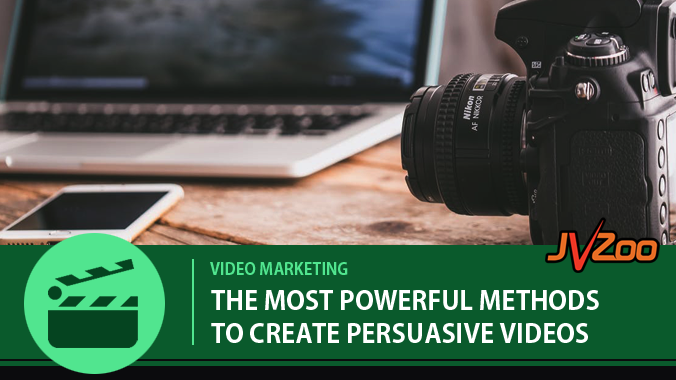Video is one of the easiest ways to deliver your message online today. Video combines three elements that cause it to capture the audience’s attention and hold it… VISUAL, AUDIO, and the one people often overlook which is MOTION. There are tons of styles of video with differing levels of production that can be used to create a captivating vessel for your message. In today’s marketplace, he who wields the power to create compelling video has the power to make big money.
There are various TYPES of videos that you can create but the first thing you need to have is a clear objective. Why are you making the video? This is important to know because different purposes require different types of videos AND different types of tools. Let’s say you’re making a sales video. You may consider getting on camera or just doing a slideshow with text animations. BUT… if you’re doing a product demo video you may be able to just accomplish that with some screen capture software to record your screen — no fancy lighting or camera required. A clear objective will guide your production decisions.
The method and the tools you decide on are just the beginning. The key to creating killer videos is to make them edutaining. That’s right — edutaining. You’ll want to both educate and entertain your audience at the same time. You should focus on the main message of the video and make it fun to watch. If you can keep your audience’s attention, you’ll be able to encourage them to take the next step, whether it’s to watch the next video, subscribe to your YouTube channel, or buy your product.
Another key point about the content is to “be yourself”. Be natural on-camera or behind the microphone if it’s a screen capture video. You don’t want to come off as someone you’re not — especially when you’re on camera. It takes everyone some time to build a natural presence on the camera, so be patient. Know that as you build experience recording, you’re also building the brand that’s going make your dreams come true. If you fake it, you will not make it!
Don’t rush the job. Making a successful video is going to require a little bit of planning. There are a few key points to consider regardless of whether you’re getting on camera or not. By having a clear vision and a plan for what you’re trying to accomplish, you can create a well-suited video for the job. Once the planning and prepping are out of the way you’ll be able to focus on edutaining your audience. Each video you create will help you become better and better at the process and will also help you establish a brand of your own! Making videos nowadays is not as hard as it used to be.
POWERFUL VIDEO IS EASIER TO MAKE THAN YOU MIGHT THINK
Being on camera doesn’t require a huge production set and thousands of dollars of equipment. You can make your own sales video or content videos with a cell phone and the computer you already have. You’ll need a few other pieces of equipment, but it doesn’t have to be super expensive. Let’s jump into the basic equipment that you’ll need to be on camera.
The first thing you’ll need is a camera and here’s the cool thing about that… chances are, the cell phone in your pocket is perfect for any sales video or lesson that you’d like to record. You make also have a webcam that works as well… but check the image quality first!
Next, you need something to hold your camera. A tripod is generally the best tool for the job. Again, you don’t need to spend hundreds of dollars on an industrial-grade tripod. A simple tripod and cell phone holding bracket from Amazon will cost just a few bucks but do the job just fine. A stable platform will help keep you in focus throughout the recording.
PRO-TIP: A selfie stick is another option if you need to record some action shots! You may be able to use your tripod as a selfie stick depending on its features and build quality.
Another important consideration is your environment. You’ll want to consider both the lighting and the background. Ideally, you’ll want to light up the subject (whoever is on camera) and the background evenly. You don’t want hotspots or shadows that make your subject look weird. A simple lightbox set from Amazon is a great start, but if you’re really on a tight budget, you can just shoot outside on an overcast day. Natural daylight and nature in the background can be very effective allies for your lighting needs.
Finally, you’re going to need a decent microphone. Studies have found that people will watch a video if the picture is terrible, but the audio is good. However, they won’t watch a video with a great picture, but terrible audio. You’ll want to capture the clearest audio possible. This is easy to do with a lavalier microphone or a shotgun microphone.
PRO-TIP: You can get a decent lavalier mic that has a long cord and plugs right into the headphone jack on your phone! On most smartphones, the headphone jack turns into a microphone input when the phone is in “record mode”.
You don’t need thousands of dollars in fancy equipment to make quality videos. Everyone is carrying a movie-quality camera in their pocket these days. You just need a method to stabilize the camera. Good lighting is a necessity as well, but you can always use the great outdoors! Finally, your audio quality can be satisfied with a decent lavalier mic. If you combine all of these components effectively, you’ll get a great video!
SCREEN CAPTURE CAN BE A GREAT SHORTCUT TO VIDEO SUCCESS
Screen capture videos are quite possibly the easiest way for newbie marketers to produce quality videos. Screen capture software allows you to record your computer screen. You can capture the activities that are happening on your screen and convert them to “over-the-shoulder” training courses or sales videos. Screen captures are great for site demos and walkthroughs, installation videos and slideshow presentations. Their simple nature makes them highly newbie-friendly, but you’ll want to look out for a few things before getting started.
First, screen capture software is not all created equal. In general, the more pricey ones have the most features. Advanced editing abilities are the biggest reason for the hefty price tag. In all sincerity, this is an area of your business where it pays off to invest in the QUALITY product. You will want to consider the more expensive screen capture software like Screenflow or Camtasia because they will give the ability to edit ALL of your video types ― not just the screen capture videos. If you choose a less expensive software, you’re going to pay for its lack of editing capabilities in one way or another.
One big advantage of screen capture videos over on-camera videos is the lack of concern over lighting. The software isn’t sensitive to the lighting of the room (but may be sensitive to your monitor’s brightness settings). However, you do have to pay attention to the colors and contrasts of the materials you’re recording. If you’re recording a slideshow presentation, you’ll want to make sure the writing is easily read and not disrupted by the background. While the screen capture does not have the same concerns about the lighting in the environment as a camera, you do need to consider the colors of the material you’re recording.
PRO-TIP: When it comes to audio quality, you can use the microphone that’s built into your laptop. However, it’s a good idea to invest in a quality USB microphone when you have the chance. Many marketers use the Blue Yeti condenser mic for its full, rich radio quality sound.
Finally, screen capture videos allow you to produce videos very quickly. That’s in part because you’re not constantly fumbling with lights, setting up a backdrop, or applying makeup. To make a screen capture video, you need only sit at your computer and turn on your software. As long as your mic is connected, you’re in business.
Anyone can create a screen capture video. JVZoo’s leaderboard is often filled with products whose sales videos are made with simple PowerPoint or Keynote presentations. Screen capture videos are the best way for a new marketer to start making their own product videos and sales videos. They’re simple, have low-production requirements, and fast to produce.
TEMPLATES ARE THE KEY TO MAKING YOUR SLIDESHOW PRESENTATIONS LOOK SUPER PROFESSIONAL
Slideshow presentations allow you to make videos, especially product videos, quickly and consistently. Starting with a template allows you to focus on the message you want to convey. With a template, your presentation is pre-formatted so you just have to change the placeholder text and record the video. Templates cut down your pre-production time and allow you to create consistent videos.
When you’re making a content video for your membership website, you may want to use PowerPoint. PowerPoint templates are easy to use, especially if you’ve grown up with PowerPoint or use it at work. You can use all kinds of visually engaging tricks, but a simple white slide with black text can be just as effective.
PRO-TIP: Black and white PowerPoints allow you to make videos that can fit a variety of campaigns. This makes them ideal for affiliate bonuses because they aren’t branded to a specific product.
One template you can create for your information products is the “5-5-5 template.” With the 5-5-5 template, you’ll create 5 slides with 5 bullet points that yield 5 minutes of talking per slide (hence 5-5-5). Each bullet point is a talking point that you can speak on for at least a minute. This gives you 25 minutes of content for each video. NOTE: You’ll also want a title slide, anchor slide, and closing slide for the template.
One final note about slideshow presentations is that you can brand them if you want to. For example, you could create a custom slide background to use in all of the videos in your training course. This is simple to implement, but lends a premium feel to the content. The only downside is that you will have to re-record the videos if you need to make a generic version. Nevertheless, slideshow presentations are easy to spice up with some custom graphics that also establish the brand.
PRO-TIP: There are many sellers on JVZoo who offer PowerPoint templates for sale. You may want to pick up a set, especially for your sales videos.
By using a template, you’ll be able to add your message and record your video quickly. You won’t have to struggle with animations after the first template is built. Templates also allow you to produce consistent branding for your training videos. You can even use them for your sales videos.
CONSIDER “LIVE STREAMING” AS PART OF YOUR VIDEO MARKETING ARSENAL
Live streaming is on the rise FAST. One reason is that anyone with a smartphone or webcam can turn any environment into a live action studio. Live streaming also has the least technical overhead — there’s virtually no editing or rendering needed. Live streaming is best employed where authority building, branding, and traffic driving are the main objectives. Live streams are easy to share, so charging for access to the stream is troublesome at best. However, if you’re willing to share your message for free, live streaming can be hard to beat!
Do you want to be a star? Live streaming is an easy way to release your message. Live streaming excels where the goal of driving traffic or building your brand is the main objective. Although most live streaming is done with a cell, you can live stream from your webcam as well.
PRO-TIP: If want, you can create an edited video and broadcast it as Live. There are many software that will connect to your Facebook account and allow you to share your pre-recorded videos. This software is especially helpful if you’re trying to create a news show.
Consider a set of talking points. In general, live streaming is supposed to be ad-libbed and informal. But if you want to make sure you’re getting your message across, you may want to draft some talking points for your video. This is really no different than a PowerPoint presentation where you simply use the bullet points to stimulate your thoughts. You’ll also want to have a call to action, such as, “go to this website” or “like, share, comment on this video.” These can be easy to forget if you get caught up in the excitement of the broadcast.
Set a regular schedule. You’re going to want to become a fixture in your audiences’ lives. This means they need you to have regular broadcasts. As your schedule becomes predictable, your most loyal followers will begin to schedule the time to watch and support your show.
NOTE: JVZoo Live airs regularly on our Facebook Fan Page. Follow our show HERE.
Live streaming is an increasingly popular way of producing video that doesn’t have nearly the technical overhead that pre-recorded video has. You simply need your phone or webcam to go live. You’ll also need a set of talking points and a call to action. Finally, you’ll only be able to build a big audience if you’ve set a regular schedule of high-value broadcasts. Live streaming is an excellent way to establish your authority and drive traffic.
YOU CAN SHOW YOUR VIDEOS ON YOUR TERMS
Once your video has been produced, it’s time to share it with the world… or just your customers. There’s a variety of considerations when deploying your videos to your audience that you’ll need to take into account. The main decision is whether your video needs to be public or if it’s exclusive to a membership site. Here’s a few considerations for getting your video in front of the right audience.
You may need a player. When you render your video, you’re likely going to use the MP4 format. The MP4 format is a highly accepted and viewable video file. Virtually any computer, tablet, and smartphone is able to play this file as is. The problem with giving your customers downloadable MP4s is that they can share them, or worse, put them on their own site and claim originality. To secure your videos, you’ll want to use a player on your site. The customer doesn’t download the MP4. Instead, they watch the video directly on your site.
PRO-TIP: YouTube is tempting to use because it’s free and they offer an unlisted video setting. However, anyone who grabs the URL to the video can share the video publicly, which will upset your paying customers big time! Use a paid player for your membership sites and protected paid content.
You may need a splash image. Even if you’ve set your video to autoplay, most mobile devices won’t allow the video to start automatically. This means that the screen will be black where the player is. There might be a white start arrow, but it will not be readily apparent to most users that they need to click the video to play it. The solution to this is to set a splash image to be displayed if the video doesn’t automatically play. The splash image can be a frame from the video itself with a simple “Tap To Play” instructions written on it. An attractive splash image will help you adapt to the increasing number of mobile users.

(This is just a sample splash image, not an actual video)
You’re definitely going to need bandwidth. Or Amazon S3. On your membership website, you’re going to have a lot of people watching videos shortly after launch. Your hosting company will track the amount of data going from your server to the customers’ devices. Because videos are enormous in size, there’s going to be a lot of data transferred. If you exceed your bandwidth limit with your hosting company they may shut you down.
One simple solution is to use a player that pulls the video data from Amazon’s S3 service. S3 is a cloud-based “Simple Storage Solution”. It will hold gigs upon gigs of data and release it on demand for pennies. Your player should pull the video from Amazon S3 (or your player’s storage account) and not your server. By connecting to S3, you’ll be able to save a ton of bandwidth, keeping your site up and running AND SAVING YOU MONEY.
PRO-TIP: Many player services will use their own S3 account to store the videos you upload to them. While you should have your own S3 account, be mindful when shopping for players that you may have to decide between their storage or connecting your S3 account to their player.
Making your video is only the first half of the battle. You then need your customers to see the video. That means you’ll need to use a common format like an MP4 that virtually all devices can play. However, the conundrum of making a video playable while keeping your premium content private has to be solved by adding a video player to your site. That player should pull the video from Amazon S3 to keep your bandwidth down. As long as you take all of these things into account, your content will end up in the hands of your customers on your own terms.

